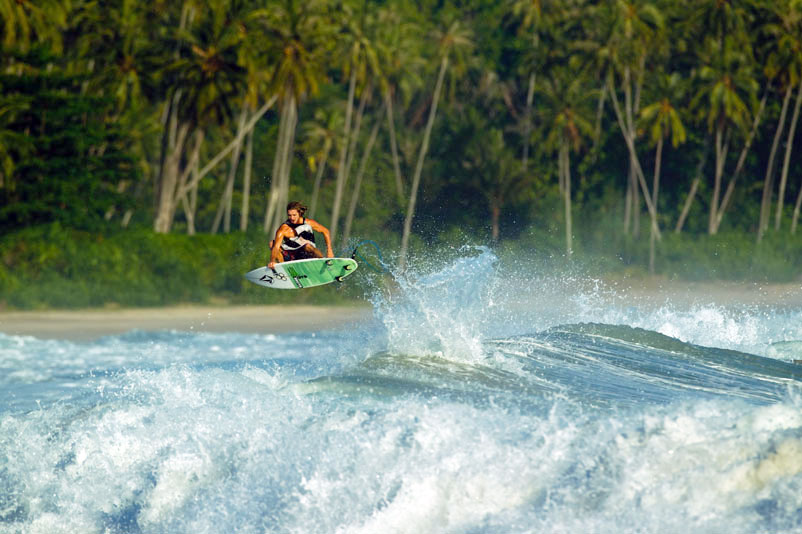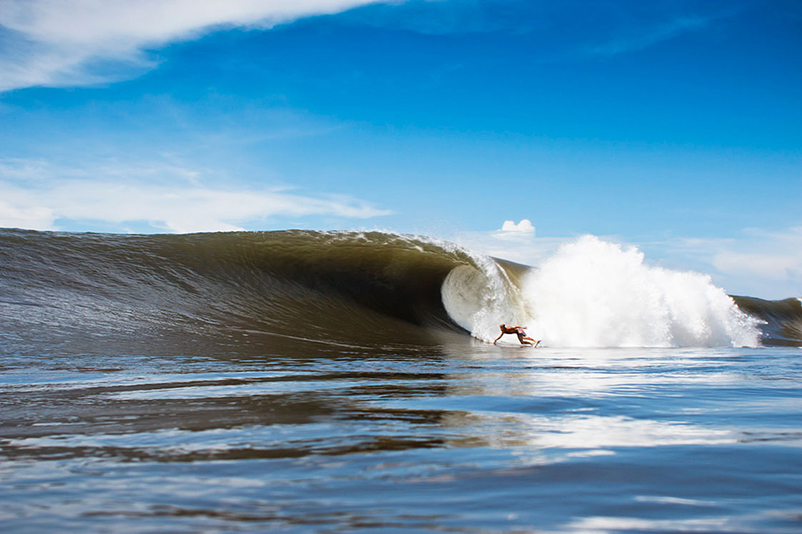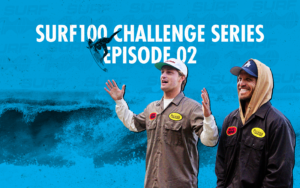Technological Digest, with Luke Davis and Nate Tyler
Words by Morgan Williamson The digital age is upon us and it rules out lives. Until artificial intelligence becomes the inevitable end of humanity, and our hopes turn to Arnie Schwarzenegger and Will Smith, tech will continue to advance. It’s the natural order. But is the increasing immediacy of everything good for surfing? It’s definitely served purpose in advancing the sport; with no technology there’d be no Samsung/WSL… “Samsung’s partnership with the WSL is a good thing,” Luke Davis tells Stab. “It makes it tighter and more professional.” The webcasts have also improved immensely. “What people get to look at now, compared to 10 years ago is night and day, tech as a whole has changed a lot in the last decade,” Luke continues. At this point, we are far removed from surfing’s ‘purism’. There’s been a grip of tech advancements that have prevailed within the sport. In a way technology has monetized on surfing, and surfers have monetized with it. If you got a GoPro, you can make a clip and win some cash. But first, you better know how to get shacked out of your silly little skull. “GoPro’s have put a camera in everybody’s hands,” Nate Tyler tells Stab. “The gnarliest chargers pull into the biggest, scariest barrels I’ve ever seen, and people just look at it like it’s a dream.” GoPro clips are responsible for a new frontier of surf porn; POV. The better people get with them, the wilder the footage becomes. Which is great. But, for the everyman, the GoPro experience may fall short of a 10-second tunnel at Desert Point. “One of my friends told me they thought their life was super interesting until they got a GoPro,” Nate laughs. “The perspective is cool, but watching people surf with GoPros is ugly.” Luke says. “They provide an insight of every surfer’s goal: To get barreled. It gives people visions that they would never be able to see. Like, Koa Smith’s 30 second-er. The average Joe surfer will never get that vision.” And when every young cat’s got themselves a camera, the result is a lot of content. The internet’s obviously the most powerful platform in surf history. Big budget surf films are overcast by the interweb’s looming shadow. “The thing is, everything’s on the web” says Luke. “It sucks because you don’t get surf movies that you have to go a shop, buy and actually own anymore. When I was younger I watched Searching for Tom Curren every day on VHS. Now, shit goes on the web, it’s there for a few days and it’s gone, people forget about it. Everything’s watered down.” So, where’s there a line? Most surf ‘films’ are made for web. Apart from the Joe G and Kai Neville movies we anticipate throughout the year, web is king. “There’s something hardwired into us now, there’s this weird need for daily content,” Nate says. “I’ve always been a real firm believer in waiting for a film to come out, sitting on stuff and trying to ‘wow’ the people. But now, I think it’s more of a struggle than anything. It’s really hard to wrap your head around how to compete with the constant flow of content. It’s kind of funny though, me dogging web edits, when I’m currently putting one out… But, the level is set so high now, and we are starting to see the full evolution of it.” It will continue to evolve and along with it, so will all the components involved in production. Nate, blending into Indonesia. Photo: Tom Carey Solo Shots crossed a new border in filming. “Those things are pretty rad,” says Nate. “I’ve never used one but if I was little frothing grom I’d be stoked, you’d never miss a clip. A lot of filmers might be pissed at me for saying that.” He laughs. But it’s true, the more robotised we make surfing, the closer we become to replacing humans, as in assembly lines. Whatever you’re doing, a machine will do it with optimum precision. But one thing that can’t be captured with a robot, is perspective… oh wait, drones are thing huh? The big difference with drones though, is they’re powered by man. They’re a cyborg extension of the filmmaker. “I wouldn’t watch a 30-minute drone surf movie, but when it’s shot right it looks pretty crazy,” says Luke. As camera-aided technology continues to develop so do the cameras themselves. “Everyone used to be able to film with 7D, now it’s like if you don’t have a RED people aren’t even filming with you,” says Nate. “It’s like a new set standard. It’s a bummer though filmers who aren’t making much money. Heads are going to explode as RED becomes the standard, and it all depends on how many K’s your camera has.” At some point you’ve got to wonder how necessary these technological advancements are. For instance, we’ve multiplied pixels so exponentially that they’re beyond our eyes’ comprehension. “RED footage is crazy, it’s way clearer than your vision,” Luke says. “Watching playback is starting to become better than real life.” So, as we advance like a bullet in zero gravity and new technologies continue to make our heads spin, the question of the ‘good’ of this exponential growth remains. After all, tech is rad, it’s enabled things never-before thought possible. We depend on it. Look what happened when United Airlines, The Wall St. Journal and The New York Stock Exchange servers crashed: People panicked, flights were grounded, it was a big who done it? But the reality is, we have so much riding on systems whose dependability is undependable, and occasional failure is inevitable. But don’t sweat: Y2K was a flop! And, if Steven Hawking’s right that “computers will overtake humans with AI in the next 100 years,” we’ll be saved without a doubt in classic Hollywood fashion. Because everything that happens in the movies, happens in real life, right? Luke, crystal clear in Bali. Photo: Damea Dorsey
Words by Morgan Williamson
The digital age is upon us and it rules out lives. Until artificial intelligence becomes the inevitable end of humanity, and our hopes turn to Arnie Schwarzenegger and Will Smith, tech will continue to advance. It’s the natural order. But is the increasing immediacy of everything good for surfing? It’s definitely served purpose in advancing the sport; with no technology there’d be no Samsung/WSL… “Samsung’s partnership with the WSL is a good thing,” Luke Davis tells Stab. “It makes it tighter and more professional.” The webcasts have also improved immensely. “What people get to look at now, compared to 10 years ago is night and day, tech as a whole has changed a lot in the last decade,” Luke continues. At this point, we are far removed from surfing’s ‘purism’. There’s been a grip of tech advancements that have prevailed within the sport. In a way technology has monetized on surfing, and surfers have monetized with it. If you got a GoPro, you can make a clip and win some cash. But first, you better know how to get shacked out of your silly little skull.
“GoPro’s have put a camera in everybody’s hands,” Nate Tyler tells Stab. “The gnarliest chargers pull into the biggest, scariest barrels I’ve ever seen, and people just look at it like it’s a dream.” GoPro clips are responsible for a new frontier of surf porn; POV. The better people get with them, the wilder the footage becomes. Which is great. But, for the everyman, the GoPro experience may fall short of a 10-second tunnel at Desert Point. “One of my friends told me they thought their life was super interesting until they got a GoPro,” Nate laughs.
“The perspective is cool, but watching people surf with GoPros is ugly.” Luke says. “They provide an insight of every surfer’s goal: To get barreled. It gives people visions that they would never be able to see. Like, Koa Smith’s 30 second-er. The average Joe surfer will never get that vision.” And when every young cat’s got themselves a camera, the result is a lot of content.
The internet’s obviously the most powerful platform in surf history. Big budget surf films are overcast by the interweb’s looming shadow. “The thing is, everything’s on the web” says Luke. “It sucks because you don’t get surf movies that you have to go a shop, buy and actually own anymore. When I was younger I watched Searching for Tom Curren every day on VHS. Now, shit goes on the web, it’s there for a few days and it’s gone, people forget about it. Everything’s watered down.” So, where’s there a line? Most surf ‘films’ are made for web. Apart from the Joe G and Kai Neville movies we anticipate throughout the year, web is king. “There’s something hardwired into us now, there’s this weird need for daily content,” Nate says. “I’ve always been a real firm believer in waiting for a film to come out, sitting on stuff and trying to ‘wow’ the people. But now, I think it’s more of a struggle than anything. It’s really hard to wrap your head around how to compete with the constant flow of content. It’s kind of funny though, me dogging web edits, when I’m currently putting one out… But, the level is set so high now, and we are starting to see the full evolution of it.” It will continue to evolve and along with it, so will all the components involved in production.

Nate, blending into Indonesia. Photo: Tom Carey
Solo Shots crossed a new border in filming. “Those things are pretty rad,” says Nate. “I’ve never used one but if I was little frothing grom I’d be stoked, you’d never miss a clip. A lot of filmers might be pissed at me for saying that.” He laughs. But it’s true, the more robotised we make surfing, the closer we become to replacing humans, as in assembly lines. Whatever you’re doing, a machine will do it with optimum precision. But one thing that can’t be captured with a robot, is perspective… oh wait, drones are thing huh? The big difference with drones though, is they’re powered by man. They’re a cyborg extension of the filmmaker. “I wouldn’t watch a 30-minute drone surf movie, but when it’s shot right it looks pretty crazy,” says Luke.
As camera-aided technology continues to develop so do the cameras themselves. “Everyone used to be able to film with 7D, now it’s like if you don’t have a RED people aren’t even filming with you,” says Nate. “It’s like a new set standard. It’s a bummer though filmers who aren’t making much money. Heads are going to explode as RED becomes the standard, and it all depends on how many K’s your camera has.” At some point you’ve got to wonder how necessary these technological advancements are. For instance, we’ve multiplied pixels so exponentially that they’re beyond our eyes’ comprehension. “RED footage is crazy, it’s way clearer than your vision,” Luke says. “Watching playback is starting to become better than real life.”
So, as we advance like a bullet in zero gravity and new technologies continue to make our heads spin, the question of the ‘good’ of this exponential growth remains. After all, tech is rad, it’s enabled things never-before thought possible. We depend on it. Look what happened when United Airlines, The Wall St. Journal and The New York Stock Exchange servers crashed: People panicked, flights were grounded, it was a big who done it? But the reality is, we have so much riding on systems whose dependability is undependable, and occasional failure is inevitable. But don’t sweat: Y2K was a flop! And, if Steven Hawking’s right that “computers will overtake humans with AI in the next 100 years,” we’ll be saved without a doubt in classic Hollywood fashion. Because everything that happens in the movies, happens in real life, right?

Luke, crystal clear in Bali. Photo: Damea Dorsey













Comments
Comments are a Stab Premium feature. Gotta join to talk shop.
Already a member? Sign In
Want to join? Sign Up